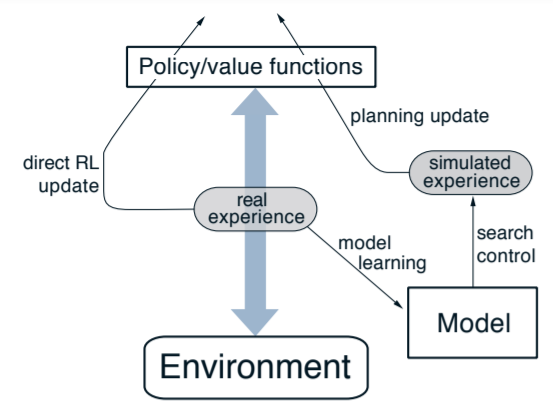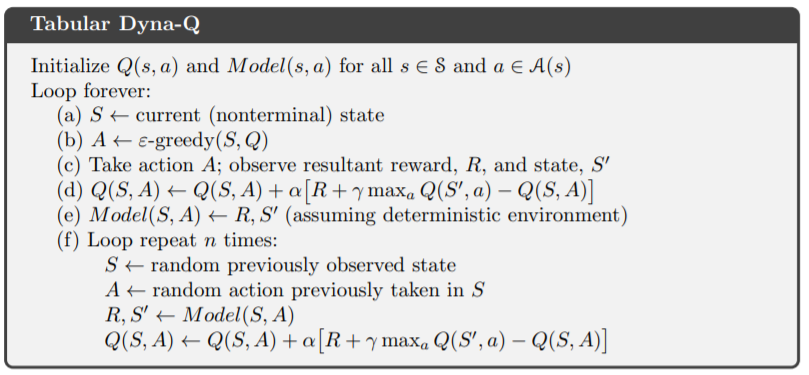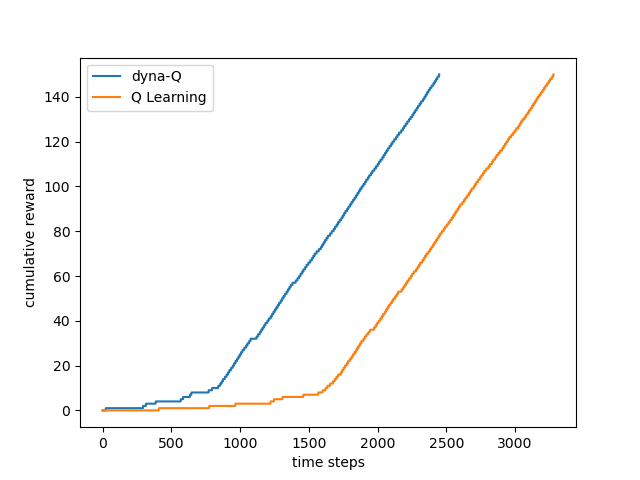dyna-Q是一種運用model與value來一起更新Value Function的方法。在與環境互動有困難的時候相當有用。
model的概念很簡單,就是Agent理解到的環境的知識。經過與環境的互動,Agent會越來越能知道環境中的dynamic,當Agent在狀態上,Agent不需要實際與環境互動,就能估計每個Action會對應到哪個狀態
。
可以想像在現實世界中,你透過書上或是新聞上知道從高處掉落會受傷,那下次你在高處時,不需要自己本身從高處烙下,也能知道該行為是不好的。這就稱為你理解的環境中的Model。但Model不一定是完整的,你已經知道從高處落下會受傷,但你並不知道從5公尺高落下會不會受傷,要等到你有其他知識或著例子來告訴你這些知識來提升你的model才行。
假如我們的model完整,理論上就能解決所有Reinforcement Learning的問題,只要運用前幾天的policy iteration或value iteration就能找到最佳解。要model完整我們需要一直sample,只要sample數夠多就能達到。但看看前幾天Taxi的例子,光是state就有500個,action又有6個,要每個state與action重複sample好幾次顯然不夠實際。
Dyna-Q就是為了解決這種情況,將q learning與model一起使用,將sample得到的reward值,用來更新Value Function與Model,再用model來更新Value Function。
我們稱用model預測下個state這個動作為planning。從圖上可以看到,有一部分的real experience通過direct RL update更新Value,這部分就是熟悉的q learning;另一部分則經過model,再透過model模擬環境的行為更新Value。
代碼也是相當簡單,除了q learning的部分,額外多了n次的planning來更新Value
只要model預測的準確的話(環境的隨機性小,像是迷宮等等),dyna-Q的收斂速度會比q learning還快許多。
先匯入必要套件
import numpy as np
import sys
from collections import defaultdict
import random
import matplotlib.pyplot as plt
準備我們的環境
class Maze:
def __init__(self):
self.pos = (3, 0)
self.barrier = (0, 7)
self.action_space = 4
def reset(self):
self.barrier = (0, 7)
self.pos = (3, 0)
return self.pos, 0, False
def step(self, action):
if action == 0: # left
new_pos = (self.pos[0] - 1, self.pos[1])
elif action == 1: # up
new_pos = (self.pos[0], self.pos[1] + 1)
elif action == 2: # right
new_pos = (self.pos[0] + 1, self.pos[1])
elif action == 3: # down
new_pos = (self.pos[0], self.pos[1] - 1)
if new_pos[0] < 0 or new_pos[0] > 8 or new_pos[1] < 0 or new_pos[1] > 5 or (new_pos[1] == 2 and self.barrier[0] <= new_pos[0] <= self.barrier[1]):
new_pos = self.pos
self.pos = new_pos
if self.pos[0] == 8 and self.pos[1] == 5:
return self.pos, 1, True
return self.pos, 0, False
環境為簡單的gridworld,走到終點reward為1,其餘為0。中間有障礙不能通過。看起來像這樣
接著實作dyna-Q演算法:
gamma = 0.95
epsilon = 0.1
alpha = 1.0
env = Maze()
def choose_action(state, Q):
if np.random.rand() < epsilon:
return np.random.randint(env.action_space)
else:
values = Q[state]
return np.random.choice([action for action, value in enumerate(values) if value == np.max(values)])
def q_update_value(state, action, reward, next_state, done, Q):
if done:
Q[state][action] += alpha * (reward - Q[state][action])
else:
Q[state][action] += alpha * (reward + gamma * np.max(Q[next_state]) - Q[state][action])
def run_q_learning(num_episodes, n = 50, render = False, planning = False):
Q = defaultdict(lambda: np.zeros(env.action_space))
rewards = 0
cumulative_reward = []
model = {}
for i in range(num_episodes):
state, reward, done = env.reset()
while True:
action = choose_action(state, Q)
next_state, reward, done = env.step(action)
q_update_value(state, action, reward, next_state, done, Q)
model[(state, action)] = (reward, next_state, done)
if planning:
for _ in range(50):
(S, A), (R, S_, done_) = random.choice(list(model.items()))
q_update_value(S, A, R, S_, done_, Q)
rewards += reward
cumulative_reward.append(rewards)
if done:
break
state = next_state
print(f'\repisode: {i + 1}/{num_episodes}', end = '')
sys.stdout.flush()
return cumulative_reward
用dict來記錄走過的model,再用model的經驗更新n次,可參考上面演算法。
注意這邊
choose_action我將原本q learning中的np.argmax改成random.choice,這是因為np.argmax在有兩個以上相同最大值時,不會有隨機選擇。
與一般Q Learning做比較,看哪個算法收斂較快
cumulative_reward_planning = run_q_learning(150, True)
cumulative_reward = run_q_learning(150)
plt.plot(cumulative_reward_planning)
plt.plot(cumulative_reward)
plt.legend(['dyna-Q', 'Q Learning'])
plt.ylabel('cumulative reward')
plt.xlabel('time steps')
plt.show()

從圖片上可以看到dyna-Q在700 steps後就能找到最佳路徑,而Q Learning要等到約1600steps後才能找到最佳路徑。
如果環境會隨時間改變的話,dyna-Q記錄到的model可能就不準確,可以使用更進階的dyna-Q+來解決,明天將會介紹。dyna-Q也有deep的版本來達成更複雜的任務。運用model來學習在reinforcement learning裡是很重要的,現實生活中我們不一定能都與環境互動,所以model是不可或缺的。
